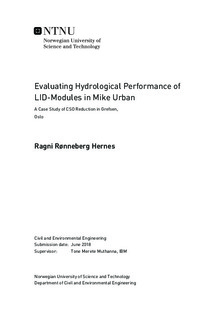Evaluating Hydrological Performance of LID-Modules in Mike Urban - A Case Study of CSO Reduction in Grefsen, Oslo
Master thesis
Permanent lenke
http://hdl.handle.net/11250/2573231Utgivelsesdato
2018Metadata
Vis full innførselSamlinger
Sammendrag
Paved surfaces, increased precipitation amounts and intensities in addition to limited capacity in the sewer systems, cause a higher risk of combined sewer overflows (CSOs). Low impact development (LID) is a possible solution to mitigate some of the consequences by managing the stormwater locally. To evaluate the effect of LID controls, the hydrological performance of the green roof (GR) and the bioretention cell (BRC) modules in the Mike Urban (MU) model have been evaluated and applied to the Grefsen catchment in Oslo. Observed data from a pilot GR and a previously tested BRC were used in the evaluation of the modules in addition to three GR parameter sets from a study using the SWMM model. The NSE index showed respectable results for 2/3 GR events compared to the results in SWMM. The BRC reached an NSE value of 0.73 post calibration. The hydrological performance of the LID modules in MU was satisfactory, but some inaccuracies in the transfer of the SWMM parameters were detected. The CSO reduction in the Grefsen catchment simulated with synthetic precipitation events presented superior results for BRCs during larger precipitation events, while GRs were proven to have beneficial outcomes during smaller events. The flow duration curve was furthermore confirmed a satisfactory analysis tool in evaluating the overall importance of LID controls. The case study approach has been valuable to test the real life complexity typically faced in modelling urban combined systems.
